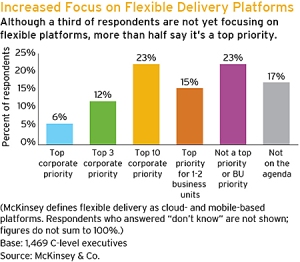To thrive in today’s swift-changing and unforgiving marketplace, companies need accessible, agile and adaptable IT. Flexible service delivery is the answer. Here’s how to employ it. In the post-PC era, IT decision makers have a choice to make: Stay with the platform that got them here? Adopt a private or public cloud? Perhaps IT as-a-service or a mix of all the above?
Whatever you decide, a move away from rigid IT infrastructures is a move in the right direction. According to a recent McKinsey & Company survey, more than half of surveyed officers cited the switch to flexible service delivery as a top priority
The reason is simple: Flexible delivery is more adaptable and costs less. It’s a smarter way to distribute IT to users.
We recently confirmed this with a large U.S.-based telecommunications client that needed its technology to scale to tens of millions of subscribers on demand and then let those same subscribers pick and choose online the services most important to them.
Originally, the company considered a traditional infrastructure and then briefly a public cloud. But after completing a holistic analysis, we determined an internal private cloud would be the best option for three reasons: 1) It met the client’s needs (i.e. time-to-market, minimal downtime, continuity and rapid scalability requirements); and 2) It was less expensive over time when compared with the public cloud; and 3) It left open the option for later incorporating a public cloud if desired.
The beta test verified that the model enabled rapid elasticity, continuity and increased uptime. Mission accomplished.
You can achieve the same results. But only after you consider the following eight recommendations we’ve used to transition clients to flexible service delivery:
1. Determine your biggest pain point.
No one’s going to say “no” to faster time to market, enhanced computing flexibility, improved performance, tighter security and better service at a lower cost. While all of those areas can certainly be addressed through flexible service delivery, the model you choose will largely depend on your top pain point. In other words, you’ll need to honestly answer the following: What keeps you up at night?
2. Decide which functions to shift.
Next, you’ll need to designate which functions and processes to switch to flexible service delivery. This entails a “core vs. context” analysis, in which you distinguish business activities that provide you with a competitive advantage from those that should be offloaded to external providers. Remember, what was previously considered a core activity is now often viewed a contextual one, including (but not limited to) network management, tech support, performance measurement and financial planning.
3. Start with a low-risk pilot program.
For established companies, it’s usually best to dip your toes into flexible delivery before diving in headfirst. You can achieve this by developing a pilot program for non-production processes, back-office functions or anything else that has lower performance requirements and less impact on end-users, such as testing and development. In some cases, however, it might make sense to start with customer-facing applications if there’s a pressing need to market new products.
4. Identify “chatty” applications.
To get the most for your money, you’ll need to determine the consumption levels of your CPU, memory, network and disk storage. In doing so, you’ll be able to identify “chatty” applications that sometimes incur surprising surcharges between the cloud provider and the business. The more you know, the more you save.
5. Mind those non-IT bottlenecks.
Once IT has been upgraded to the equivalent of a 12-lane highway with the help of flexible delivery, other parts of the organization cannot remain in horse-and-buggy mode. Well, they can. But they’ll become a bottleneck to your business. The challenge is to optimize the entire enterprise so that other areas don’t hold up the software lifecycle. To do this, you’ll need to educate and update your company culture.
6. Compare service requirements.
Buyer beware: Most public cloud providers offer standard service level agreements that cannot be customized according to client needs. In some cases, general service levels may be sufficient for a development environment. But they often fall short of the demands of a production environment. To find a service level best suited to you, you’ll need to know the difference.
7. Check security qualifications.
Security is a top-of-mind consideration, particularly for applications and systems that handle personal information. To ensure your data is protected, always certify a provider’s security qualifications. And know that cloud providers typically conduct security audits at a more intensive level than companies hosting internal private clouds.
8. Demand transparency with a daily dashboard.
To manage variable costs, you’ll want to monitor your capacity and all of its operational parameters — straight down to the lowest server — with a daily dashboard. With this level of transparency, you can make day-to-day decisions about the level of CPU, memory and storage required and use metrics and trends to make decisions about future capacity financial modeling.
Admittedly, the changes required to move to a flexible service delivery can seem overwhelming. But by following the above advice, you’ll put yourself in a better position to find your own success.
For more information, read our white paper on Flexible Service Delivery (pdf), get inspired by our enabler series on The Future of Work or visit Cognizant Business Consulting.
Uncover the key factors to consider before designing a flexible service delivery model. Read on to find out more:

